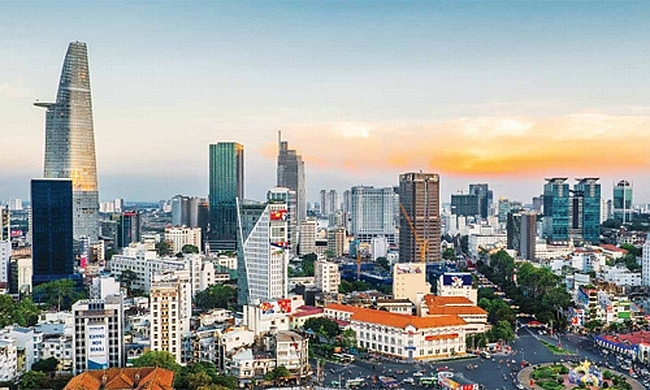The leading economic engine Ho Chi Minh City drops its growth due to COVID-19
 |
| The leading economic engine Ho Chi Minh City drops its growth due to COVID-19 |
The Ho Chi Minh City Statistical Office has just released the August report on the socioeconomic development situation in the city. Major highlights include sharp drops in the index of industrial production (IIP), the number of newly-established enterprises, and total retail and consumption services revenue.
Manufacturing at the breaking point
The statistical office estimated that the city's IIP in August contracted by 22.4 per cent on-month, with the indice of the mining industry dropping 49.7 per cent, processing and manufacturing by 22.9 per cent, electric production and distribution by 9.9 per cent, and water supply and waste treatment by 6.7 per cent.
Thus, the IIP of the city declined by 6.6 per cent on-year, including the decrease of 2.6 per cent in the mechanical industry, 5.3 per cent in pharmaceuticals, 6.7 per cent in electronics manufacturing, and 8.7 per cent in food and beverage.
The IIP of some traditional industries reduced during the period, including a 6.9 per cent fall in the textile industry, 6.9 per cent in leather and leather products, and 18.5 per cent in clothing production.
Meanwhile, the consumption index of the processing and manufacturing industries in August was estimated to decrease by 27.7 per cent on-month and 53.4 per cent on-year. Accumulated over the first eight months of the year, the consumption index reduced by 7.2 per cent on-year.
The inventory index of the processing and manufacturing industries in August was estimated to raise 11.4 per cent on-year. Some industries reported a super-high increase, including leather and leather products (644.1 per cent), and manufacturing oftransport vehicles (76.4 per cent).
"Industrial production in Ho Chi Minh City in August faces huge woes that almost broke production and manufacturing activities as the city is turning all resources to controlling COVID-19," highlighted the report.
Sharply lessening newly-established businesses FDI
The outbreak of the health crisis and social distancing in the city has halted most business operations and had a great impact on investor psychology. Specifically, only 265 enterprises registered new and added capital in the first half of August with a total capital of VND6.646 trillion ($288.96 million). So the number of new enterprises and newly-registered capital reduced by 85.5 and 95.4 per cent on-year, respectively.
Between January 1 and August 15, Ho Chi Minh City granted investment certificates to 21,762 new enterprises with the total capital of VND365.2 trillion ($15.9 billion), down 15.9 and 34.1 per cent on-year.
Additionally, according to the General Statistics Office, in the first eight months, 85,500 enterprises shut down. 24,000 of these businesses were in the virus-hit Ho Chi Minh City, accounting for 28.1 per cent of total closures in the country.
While total foreign investment flowing into the country in the first eight months reduced by over 2 per cent, only $2.18 billion reached Ho Chi Minh City, a sharp decrease of 43.6 per cent on-year.
The drop of retail and consumption service expenses
The report of the city's statistical office also showed total revenue of retail and services in August dropping significantly due to COVID-19. Total retail and consumption service revenue during the month was estimated at VND35.522 trillion ($1.54 billion), a decrease of 15.9 per cent on-month, and 59.4 per cent on-year. Retail revenue in August were estimated at VND24.188 trillion ($1.05 billion), a drop of 15.9 per cent on-month and 49.3 per cent on-year.
Generally in the first eight months, total retail and consumption service revenue was estimated at VND609.35 trillion ($26.5 billion), down 10.6 per cent on-year.
What the stars mean:
★ Poor ★ ★ Promising ★★★ Good ★★★★ Very good ★★★★★ Exceptional
 Tag:
Tag:
Related Contents
Latest News
More News
- Ho Chi Minh City hits $8.37 billion in FDI (December 29, 2025 | 08:28)
- Tax sector wraps up 2025 and sets priorities for next year (December 25, 2025 | 14:00)
- Heavy industries set for pilot greenhouse gas quotas (December 25, 2025 | 10:00)
- $250 million deal targets women-owned SMEs, sustainable agriculture (December 22, 2025 | 17:40)
- UOB sees Vietnam growth easing in fourth quarter (December 22, 2025 | 17:39)
- Government moves to establish International Financial Centre (December 21, 2025 | 21:00)
- Vietnam's IFC to target global investment flows (December 21, 2025 | 18:00)
- Ha Tinh breaks ground on major Vingroup industrial and energy projects (December 19, 2025 | 18:24)
- EVN launches major power infrastructure projects nationwide (December 19, 2025 | 18:17)
- VAL inaugurates second production line to meet domestic animal feed demand (December 19, 2025 | 16:37)




























 Mobile Version
Mobile Version